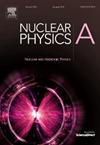超相对论核碰撞中粒子比和冻结参数对碰撞能量的依赖
IF 1.7
4区 物理与天体物理
Q2 PHYSICS, NUCLEAR
引用次数: 0
摘要
本文研究了在超相对论核-核碰撞(URNNC)中形成的多组分热致密强子共振气体(HRG)的热化学冻结条件。在本分析中使用的范德华(VDW)型模型包含了强子之间的排斥和吸引相互作用。重子(反重子)被视为不可压缩的物体。利用该理论方法,通过分析同质量反重子与重子之比的实验数据,在较宽的碰撞能量范围内提取了系统的模型冻结参数值。发现同样的一组参数可以很满意地解释其他几个粒子比的能量依赖性。我们发现奇异粒子与介子之比中的角状结构作为碰撞能量的函数不能单独用VDW-HRG模型来解释,而不考虑系统中的奇异不平衡效应。我们已经把我们得到的冻干线和以前得到的进行了比较。还研究了p¯/p和K−/K+比率之间的相关性。本文章由计算机程序翻译,如有差异,请以英文原文为准。
Collision Energy Dependence of Particle Ratios and Freeze-out Parameters in Ultra Relativistic Nucleus Nucleus Collisions
This work investigates the thermo-chemical freeze-out condition of the multi-component hot and dense hadron resonance gas (HRG) formed in the ultra-relativistic nucleus-nucleus collisions (URNNC). The van der Waals (VDW) type model used in the present analysis incorporates the repulsive as well as attractive interactions among the hadrons. The baryons (antibaryons) are treated as incompressible objects. Using this theoretical approach the values of the model freeze-out parameters of the system are extracted over a wide range of collision energy by analyzing experimental data on like-mass antibaryon to baryon ratios. The same set of parameters is found to explain the energy dependence of several other particle ratios quite satisfactorily. We find that the horn-like structures seen in the ratios of strange particles to pions as a function of the collision energy cannot be explained by the VDW-HRG model alone without considering the strangeness imbalance effect in the system. We have compared our freeze-out line with those obtained earlier. The correlation between the and ratios is also examined.
求助全文
通过发布文献求助,成功后即可免费获取论文全文。
去求助
来源期刊

Nuclear Physics A
物理-物理:核物理
CiteScore
3.60
自引率
7.10%
发文量
113
审稿时长
61 days
期刊介绍:
Nuclear Physics A focuses on the domain of nuclear and hadronic physics and includes the following subsections: Nuclear Structure and Dynamics; Intermediate and High Energy Heavy Ion Physics; Hadronic Physics; Electromagnetic and Weak Interactions; Nuclear Astrophysics. The emphasis is on original research papers. A number of carefully selected and reviewed conference proceedings are published as an integral part of the journal.
 求助内容:
求助内容: 应助结果提醒方式:
应助结果提醒方式:


